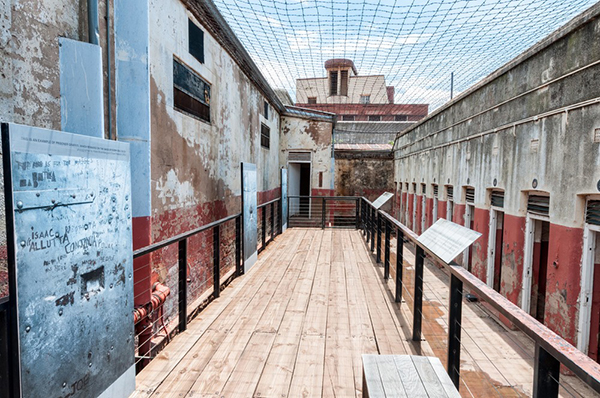NEWSLETTER
|
Visions of Johanna Inside the museums, apartheid goes on trial By Gerard Salole
The article was written when Gerry Salole was the Foundation’s representative in South Africa. He now is chief executive of the European Foundation Centre in Brussels.
Johannesburg, South Africa, is a city redolent with symbols that attest to the increasing maturity of the South African body politic. Elaborate murals, street art, graffiti, music and theater, newspaper headlines, billboards, political talk shows, election posters, advertisements and lively public spaces abound and dominate this city.
The profusion and rich diversity of these messages are poignant reminders of the demise of apartheid and the uncanny ability of South Africans to grapple directly and unambiguously with race, oppression, gender and class differences. In particular, the previously dilapidated inner city is slowly but palpably being revitalized into a huge living museum that encapsulates some of the reconciliation, forgiveness and remembrance that characterize what some call the post-apartheid miracle.
This has been, so far, a year full of promise and political symbolism for us living in South Africa. Autumn brought the excitement of the tenth anniversary of the end of the apartheid state and the beginning of democracy. In April, the nation observed its third democratic elections, which were won predictably and decisively by the African National Congress. In May, almost as a reward for ten years of democracy, we were awarded the Soccer World Cup for 2010. (The excitement was tinged with sadness, however, when ex-president Nelson Mandela, who played a crucial role in securing the World Cup bid, announced his “retirement from retirement” and asked for some respite from the grueling schedule he has maintained since leaving prison on February 11, 1990.)
Nevertheless, we will be celebrating the ten-year milestone and the soccer bonanza all year. Almost every institution in the country is finding an excuse to commemorate, celebrate, advertise and punctuate the decade-long demise of apartheid and the advent of democracy.
The seemingly effortless embrace of both the ugly past and optimistic future is part of the panache with which South Africans have taught the world a valuable lesson about remembrance and forgiveness. This is not mere juxtaposition of one against the other but rather a veritable intermingling of history and future. Nowhere is this more pronounced than in the city’s newest public space—the Constitution Hill Precinct. It is a 27-acre site containing four former prisons dating from the turn of the nineteenth century: the Old Fort, which held only white prisoners, with the notable exception of Nelson Mandela; the Women’s Jail; the Awaiting Trial Block, which was mostly demolished to make way for the Court; and the notorious and dreaded “Number Four”, which housed political activists, common petty criminals, people caught without a passbook, brewers of illegal beer, homosexuals, prostitutes and “terrorists.”
One of the most bitterly ironic aspects of the Constitutional Hill site is the rehabilitation of the apartments that overlook “Number Four”. From the balcony of these flats, the residents had a look straight into the ekhulukuthu (deep hole) isolation cells, the open-air filthy latrines and the ugly and unspeakable things that were done to the inmates.
The three surviving prisons now are museums and they sit beside the splendid new quarters for South Africa’s Constitutional Court. The seventy-five million dollar million Constitution Hill development is an integral part of the inner-city renewal process. When it is completed, it will comprise museums, exhibition spaces, restaurants, cafes, offices, hotel and shopping district. The precinct is a powerful symbolic testimony to South Africa’s current remarkable collective state of mind. The juxtaposition of these squalid prisons, the promise of the Constitutional Court and the revival of the inner city all fill me with tremendous confidence and optimism that this country seems to be getting some very important things right and that there will be more to follow.
Yet despite these impressive successes, at a deeper, more structural level there are serious problems that threaten to undermine South Africa’s hard-won gains. For one thing, unemployment is still high and the chasm between rich and poor shockingly wide. More than 500,000 jobs have been lost since 1994 and the unemployment rate stands at 41.8 percent. South Africa’s housing and sanitation backlogs are estimated at three million households, while four million households still live without access to electricity and 12 million people do not have access to clean drinking water.
Perhaps most worrisome is the incidence of H.I.V.-AIDS, which is the highest in the world. This year alone, an estimated 375,670 South Africans are expected to die from H.I.V.-AIDS. The country has been deeply traumatized by the onslaught of this epidemic, which is exacerbated by the failure of the government and economy to meet basic life needs.
But despite these serious problems, South Africa is making real progress in solving them. Its constitution is renowned the world over as one of the most progressive. It is a country full of hope as a new and vibrant democracy opens the space for engagement around policy and legislative frameworks that will make a palpable difference to the lives of the poor and marginalized. As just one example of the progress made over the last ten years, government efforts have resulted in the provision of access to clean water to more than seven million people and the construction of 1.4 million housing units.
It is an impressive and promising beginning.
The Ford Foundation in South Africa
Pioneering Human Rights by Sheila Avrin McLean
Visions of Johanna: Inside the museums, apartheid goes on trial by Gerry Salole
Letter: The Ford Foundation in South Africa by Willard Hertz
|


